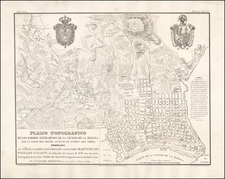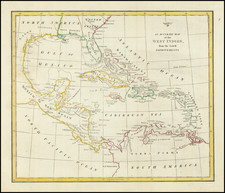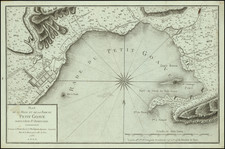Extremely Rare Chart of the Battle of Havana (1748) Justifying Rear-Admiral Sir Charles Henry Knowles's Conducted.
The second known example of this wonderful separately-issued engraved diagram of the final naval engagement of the War of Jenkin's Ear (Guerra del Asiento).
The chart is a work of military apologism, the likes of which were often issued in 18th-century Britain in the wake of major actions that were less than completely successful. For while the Battle of Havana was a nominal victory for the British Rear-Admiral Sir Charles Henry Knowles, he fell short of completely capturing or destroying the Spanish squadron; only one ship (Conquistador) was captured, while four managed to retreat to the safety of Havana. The recriminations that followed were incredibly severe; Sir Charles publicly criticized most of his subordinates for their conduct, while they in turn petitioned the Admiralty to have him court-martialed, a rather exceptional course of action for the time. Two duels followed: one between Sir Charles and Holmes, and another between two of his captains, Innes and Clarke, in which Innes was killed. King George II himself intervened to forbid any more dueling over the Battle.
Sir Charles was aware of the coming end of the war with Spain, having already been informed of Britain's peace with France, and wanted to capture prizes and glory before it was too late. However, contemporary and historical assessments of his conduct during the battle highlight a lack of unit cohesion and a failure to capitalize on massive missteps by the Spanish Admiral Don Andres Reggio.
This map attempts to combat criticism of Sir Charles by presenting his alternative option for opening the engagement as worse than the one that he actually pursued. Thus, we are shown "This Line shews the disadvantage the English Squadron must have layn under, had they form'd the Line of Battle first on the Larboard Tack (without making the small Trip to Windward they did) as they would have been so far to Leeward of the Enemy". This must have been a matter of particular acrimony among the Rear-Admiral and his subordinates. Essentially, Sir Charles would have given up the weather gauge, which Reggio offered him out of his own miscalculation, if he had chosen to form the line of battle immediately before working slightly to windward.
The Battle of Havana (1748)
The following is a lightly edited excerpt from Wikipedia's entry on the Battle:
In April 1747 Admiral Sir Charles Henry Knowles had become commander in chief on the Jamaica station but had failed to subdue Santiago de Cuba the following year. After having his ships had refitted at Port Royal Knowles sailed on a cruise in search of Spanish treasure convoys hoping to intercept the Spanish treasure fleet off Cuba before news came of a final peace between Spain and Britain. By this time news of the peace between France and Britain had arrived but no news had been received as of the latter's peace with Spain so Knowles sailed on.
On 30 September he fell in with HMS Lenox, under Captain Charles Holmes, who reported that he had encountered a Spanish fleet some days earlier. Admiral Don Andrés Reggio, commanding the Havana Squadron, left Havana on 2 October with the intention of protecting Spain's shipping lanes from raids by British forces. His undermanned crews were supplemented by a regiment of troops and several hundred conscripts on board. The wind was easterly and varied in intensity throughout the day but diminished significantly around mid-day and picked up again in the early afternoon.
On the morning of 1 October 1748, the Havana Squadron under the command of Admiral Don Andres Reggio was sailing North in a disorganized formation off of Havana. Reggio sighted what he believed to be a Spanish convoy and thus with the intention of offering escort to this "squadron" he signaled his command to bear directly on a course to intercept it. Around the same time Admiral Sir Charles Henry Knowles, commanding the British Jamaican squadron, sighted a formation of vessels on a course directly towards him and immediately signaled his own squadron to form line ahead bearing North. His intention was to put sufficient distance between himself and the Havana Squadron which would enable him to gain the weather gauge and close in.
Reggio realized the convoy he had sighted was in actuality the British Jamaican squadron. Immediately he signaled his command to steer to leeward to facilitate the formation of a line ahead bringing him to almost the same course as Knowles. The result of this, however, meant that he had lost the weather gauge whilst Knowles on the other hand was in a favorable position to obtain it. Knowles gave the signal for the ships in his line to "lead large" with the Spanish on a more convergent course. With the afternoon change in the wind, the two leading ships Canterbury and HMS Warwick in Knowles' line drifted within long range of Reggio's center which then opened fire on them. Knowles had issued standing orders to his entire command to hold their fire but despite this, the lead ships returned the fire of the Spanish.
Due to the slowness of Warwick's progress, Knowles ordered HMS Canterbury to pass her at 3 pm. However, it was not until 4 pm that the Knowles' flagship HMS Cornwall, and HMS Lenox entered the engagement. This time the combined British ships battered the Spanish and inflicted heavy damage on Conquistador which had soon lost fore and mizzen masts and could only maneuver in a small way.
Cornwall held its fire until shortly after 4 pm when it comes within pistol range and unleashed a broadside into Reggio’s Africa. Ahead, HMS Strafford poured broadsides into Conquistador while Lenox joined the action from astern. At 4:30 pm, HMS Strafford came up close and fired a devastating broadside into the Conquistador; after which she was unable to reply. Within less than an hour, Conquistador was battered out of the Spanish line, its captain and two lieutenants lying dead, and so, soon after, struck to Strafford before another broadside could do any more damage. Strafford had failed however to send any boats to take possession of her and Reggio recognized this fact and forced Conquistador to re-hoist her colors by firing on her from his flagship Africa. HMS Cornwall came up in support with an angry Knowles along with Canterbury - finally, Conquistador again struck her colors to Cornwall. Canterbury's captain however later claimed that Conquistador had struck to her subsequent to her entrance into the battle. HMS Warwick finally appeared ready to overtake the Spanish by 5:30 pm and with this, every Spanish ship attempted to save themselves, Strafford and Canterbury attempted to rest away Africa while HMS Tilbury and HMS Oxford pursued the vice flag Invencible.
By 9:00 pm, Invencible appeared silenced, but the British were too weak to prevent its escape. HMS Cornwall having been slowed down by the loss of her fore-topsail but Strafford and Canterbury pounded Africa until its main- and mizzenmasts fell. However, with night falling fast the Royal Navy ships are unable to pursue, so broke off at 11 pm to begin setting up jury-rigging and claw back out to sea.
Of Regio's Squadron, four ships returned to Havana's harbor, whilst Conquistador had been captured during the action Invincible had suffered heavy damage and avoided capture by a very narrow margin. Africa, the flagship, was dismasted and badly damaged that she retreated into a small bay 25 miles east of Havana to make repairs. Knowles, with a lead part of his squadron Cornwall and Strafford, headed eastward on 14 October and soon discovered her and opened fire. The stranded crew cut Africa's cables set her on fire and ran on her on shore; an hour later, further helped by British cannon fire, she blew up.
Rarity
Extremely rare; no copies located in OCLC nor in RBH. An example is illustrated online as part of the Royal Trust Collections having descended from the Duke of Cumberland through George III.









![[Florida & Cuba] Pas Kaart Van De Boght van Florida Met de Canaal Tusschen Florida en Cuba Door Vooght Geometra . . .](https://storage.googleapis.com/raremaps/img/small/48162.jpg)
![West Indies and Central America [Bermuda inset]](https://storage.googleapis.com/raremaps/img/small/89941.jpg)


![The Coast of Newfoundland From Plancentia to Cape Bonavista [and] A Draught of the River Plata in South America [and] Havana, Harbour [and] the Bay of Honda](https://storage.googleapis.com/raremaps/img/small/38599.jpg)
